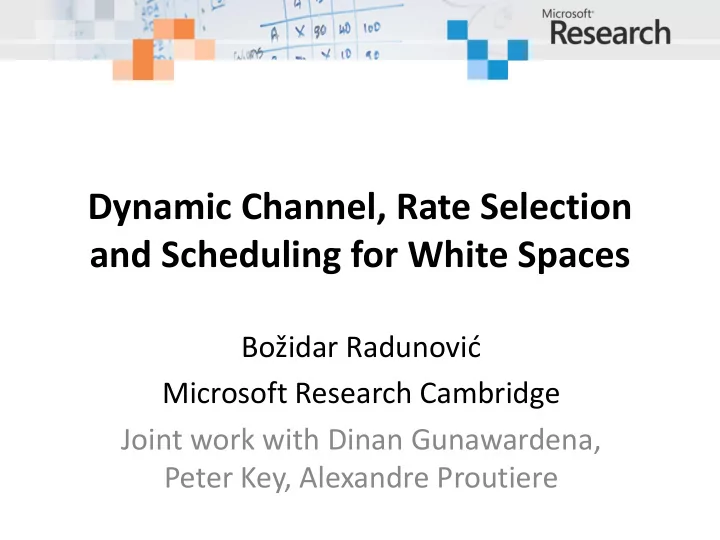

Dynamic Channel, Rate Selection and Scheduling for White Spaces Božidar Radunović Microsoft Research Cambridge Joint work with Dinan Gunawardena, Peter Key, Alexandre Proutiere
White Spaces • Only 5% of licensed spectrum is used • Primary users: – Incumbents (analogue TVs, wireless MICs) • Secondary users: – unlicensed users • White-space regulations (TV bands): – Rulings: FCC, OFCOM – More to come (Canada, Brazil, …) • Potentially large number of channels
Exploit Best Channels • Problem: channel selection – On average 20 available channels – How to use channel diversity? • Goal: each link to its best channel • Primaries specified in geo-database – no need for sensing Our work: 1) Measurements to quantify benefits 2) Algorithm to exploit benefits
Indoor white-space test-bed • 5 SDR nodes • TV Bands: – 500MHz – 600MHz – 11 channels • OFDM WiFi-like PHY in FPGA – 10 MHz bandwidth – 3 QPSK data rate (4.5, 6, 6.75 Mbps) • Send 10 pkts batch on each rate, in each freq.
Measurements - Fading Goodput [Mpbs] Auto correlation Time [s] Time lag [s] • Fast variations – Too fast to track and learn – treat as noise • Slow variations larger than fast ones – Time-scale is ~ 10s or more
Measurements - Correlation Goodput [Mpbs] Time [s] • Slow fading is not correlated across channels • It is important to track all channels
Measurements - Rates Pkt. Success rate RSSI [dB] • RSSI does not give accurate channel information • Difficult to infer success rate at one rate from another
We Gain from Adaptation Tracking the best channel Corresponding Per-channel performance best channel and rate
Channel, Rate and Access Problem 1. RSSI is poor predictor 2. Different channels are not correlated • Packet loss detected. What to do? Retransmit: – at a lower rate? – at a different channel? – Simple heuristics (SampleRate, AARF) for rate adaptation will not work. • Periodical probing for changes? – When do we have enough measurements to decide?
Learning Problem • We consider two scenarios: – Single link and AP downlink • Problem: – Given past TX successes and failures – Specify the (channel,rate,node) to use next – Goal is to maximize network utility • Key difficulty - Large number of states: – (11 chan. 3 rates = 33 states) – Slow learning – inefficient algorithm
Outline of the algorithm • Balance exploration and exploitation – Adaptation of UCB algorithm for non-stationarity • Soft sampling: – Leverage correlation among rates to speed up learning • Opportunistic channel sampling – Speed up learning through overhearing • Multi-user scheduling – Balance opportunity and fairness among users
Soft Sampling • Success at rate R implies success at all rates r < R • Failure at rate R implies failure at all rates r > R • Soft (fake) samples Failure at r=1 • Intuition: F 1 F 2 1 0 F 3 – Failure at r=2 => • SS: Failure at r=3 • SS: Failure at r=3 w.p. (F1/F2) Failure at r=2
Implementation/Evaluation • Evaluated in an SDR testbed – MAC implemented in DSP – Standard OFDM in FPGA • Implementation issues: – Channel selection and synchronization cost – Signaling for opportunistic sampling
Test-bed Evaluation Mbps • Single link: – Avg. 35.7% • Multiple links:
Conclusions • Channel and rate selection is challenging – Large number of choices – Limited prediction information • Several contributions: – Detailed channel measurements – Fast estimation algorithm – Fair scheduling in conjunction with learning • Future work: – Generalize to different topologies – with interaction
Recommend
More recommend